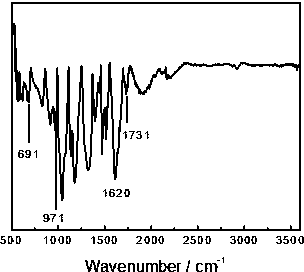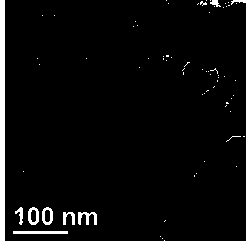Per-oxidized poly(3,4-ethylenedioxythiophene-graphite oxide (PEDOT/GO) modified electrode and electrochemical detection method thereof to pesticide imidacloprid
A technology for modifying electrodes and peroxidation, which is applied in the field of electrochemical analysis and detection, can solve the problems of high price of mercury drop electrodes, environmental pollution, complicated electrode preparation process, unsuitable popularization and application, etc., and achieves simple and fast preparation method and fast and accurate detection method. , the effect of less drug dosage
- Summary
- Abstract
- Description
- Claims
- Application Information
AI Technical Summary
Problems solved by technology
Method used
Image
Examples
Embodiment 1
[0025] (1) Grind the glassy carbon electrode on 0.1 and 0.03 μm alumina to smooth, rinse with water and acetone, and set aside.
[0026] (2) Dissolve GO in a certain amount of mixed solvent of ethanol and water (volume ratio 1:1) to form 2 mg ml -1 3,4-ethylenedioxythiophene (EDOT) was added to the solution under stirring to a concentration of 0.01M, and after ultrasonication for 60 minutes, a dark brown uniformly dispersed mixed solution was formed. The solution was added to the electrolytic cell device and passed through nitrogen for 20 minutes.
[0027] (3) In this solution, a three-electrode system was used, the saturated calomel electrode was used as the reference electrode (20°C), the platinum electrode was used as the counter electrode, and the glassy carbon electrode was used as the working electrode. Using cyclic voltammetry, the adjustment potential window is 0.2~1.2V, and the scanning speed is 200mV s -1 , scan 3 circles. The obtained modified electrode was rinse...
Embodiment 2
[0030] (1) Grind the glassy carbon electrode on 0.1 and 0.03 μm alumina to smooth, rinse with water and acetone, and set aside.
[0031] (2) GO was dissolved in a certain amount of mixed solvent of ethanol and water (volume ratio 1:1) to form 0.5 mg ml -1 solution, EDOT was added under stirring to a concentration of 0.002M, and after 30 minutes of ultrasonication, a dark brown uniformly dispersed mixed solution was formed. The solution was added to the electrolytic cell device, and nitrogen gas was passed for 5 minutes.
[0032] (3) In this solution, a three-electrode system was used, the saturated calomel electrode was used as the reference electrode (20°C), the platinum electrode was used as the counter electrode, and the glassy carbon electrode was used as the working electrode. Cyclic voltammetry was used, the potential window was adjusted to -0.2~1.0V, and the scanning speed was 50mV s -1 , scan 20 circles. The obtained modified electrode was rinsed repeatedly with eth...
Embodiment 3
[0035] (1) Grind the glassy carbon electrode on 0.1 and 0.03 μm alumina to smooth, rinse with water and acetone, and set aside.
[0036] (2) GO was dissolved in a certain amount of mixed solvent of ethanol and water (volume ratio 1:1) to form 1 mg ml -1 EDOT solution was added under stirring to a concentration of 0.005M. After ultrasonication for 40 minutes, a dark brown uniformly dispersed mixed solution was formed. The solution was added to the electrolytic cell device, and nitrogen gas was passed for 15 minutes.
[0037] (3) In this solution, a three-electrode system was used, the saturated calomel electrode was used as the reference electrode (20°C), the platinum electrode was used as the counter electrode, and the glassy carbon electrode was used as the working electrode. Cyclic voltammetry was used, the potential window was adjusted to 0-1.1V, and the scanning speed was 100mV s -1 , scan 10 circles. The obtained modified electrode was rinsed repeatedly with ethanol an...
PUM
 Login to View More
Login to View More Abstract
Description
Claims
Application Information
 Login to View More
Login to View More - R&D
- Intellectual Property
- Life Sciences
- Materials
- Tech Scout
- Unparalleled Data Quality
- Higher Quality Content
- 60% Fewer Hallucinations
Browse by: Latest US Patents, China's latest patents, Technical Efficacy Thesaurus, Application Domain, Technology Topic, Popular Technical Reports.
© 2025 PatSnap. All rights reserved.Legal|Privacy policy|Modern Slavery Act Transparency Statement|Sitemap|About US| Contact US: help@patsnap.com



